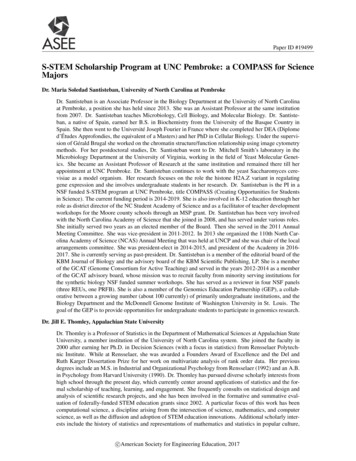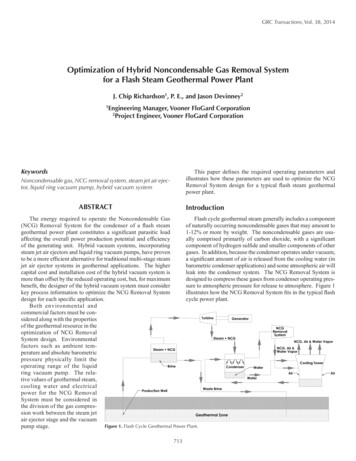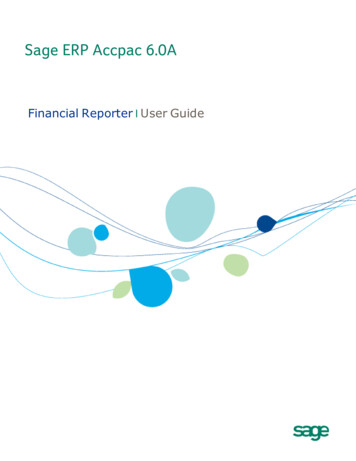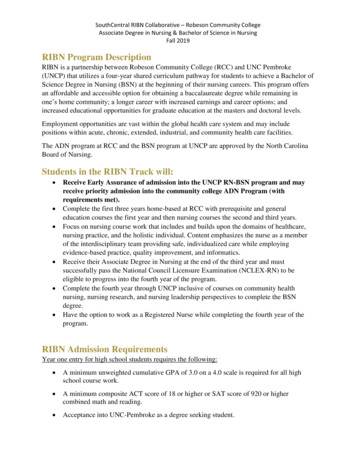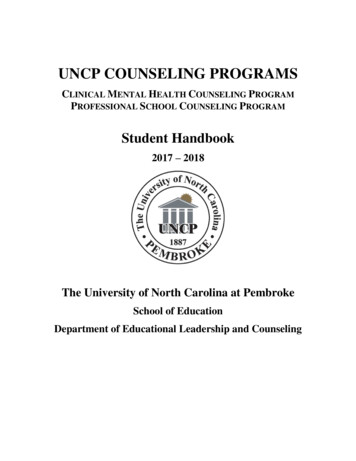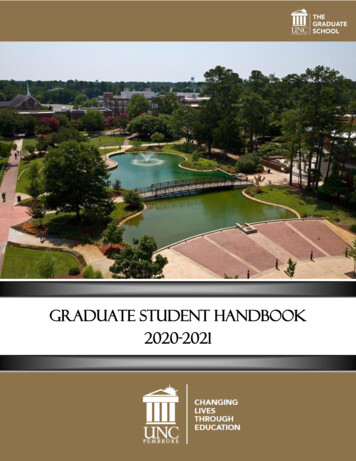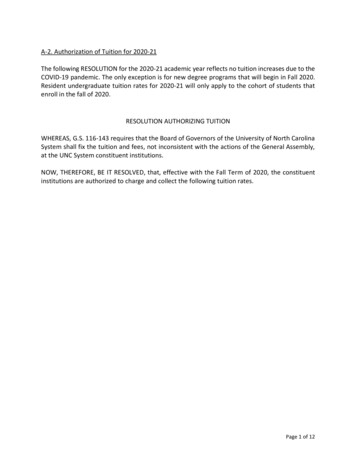
Transcription
The University of North Carolina at Pembroke:A Catalyst for Economic DevelopmentAugust 2016People Business CommunityNCGrowth.unc.edu
Brandi Bullock is an Economic Development Analyst withNCGrowth. She is also an MBA candidate in the School ofBusiness at the University of North Carolina at Pembroke.Brandi Bullock@kenan-flagler.unc.eduMeredith Bunnel is an Economic Development Analyst withNCGrowth. She is also an MPP candidate at the Sanford Schoolof Public Policy at Duke University and a licensed attorney(2008 JD, University of Pittsburgh).Meredith Bunnel@kenan-flagler.unc.eduCarolyn Fryberger is the Program Coordinator for NCGrowth.Carolyn received her Master’s Degree in City and RegionalPlanning from UNC Chapel Hill in 2014 with a specialization inEconomic Development.Carolyn Fryberger@kenan-flagler.unc.eduPeople Business Communitywww.NCGrowth.unc.eduNCGrowth, an EDA University Center at the University of North Carolina at ChapelHIll, was founded in 2012 to help businesses create good jobs and to helpcommunities create sustainable and equitable opportunities for their citizens. With apassionate staff and a dynamic pool of graduate student analysts, we partner withbusinesses, communities, governments, and other organizations to tackleoutcome-based economic development and entrepreneurship projects. NCGrowth isfunded by the Frank Hawkins Kenan Institute of Private Enterprise, US EconomicDevelopment Administration, GoldenLEAF Foundation, and Z Smith ReynoldsFoundation.
“The concept of highereducation has certainlymorphed from the old andrather “unengaged” ivorytower notion to a new,highly engaged,place-based orcommunity-basedconcept.”-Eugenie Birch, David C. Perry,and Henry Louis Taylor, Jr.Universities as Anchor Institutions (2013)
TABLE OF CONTENTS67INTRODUCTIONProject IntentExecutive Summary89COMMUNITY PROFILECommunity Profile: Pembroke, NCPembroke Business Landscape101112UNIVERSITY PROFILEOverview & HistoryEconomic ImpactCurrent Local Economic Engagement19ANCHOR INSTITUTION BACKGROUND & INITIATIVESOverviewAIED Project Types & ExamplesSuccess Stories:16 West Philadelphia Initiatives (Penn)17 The Evergreen Initiatives (Cleveland, OH)18 Fifth Season Cooperative (Wisconsin)Best Practices for Successful AIED Projects20212224OPPORTUNITIES & RECOMMENDATIONSSteering CommitteeCapacity Building & SustainabilityNext Steps: Vendor Ready InitiativeLooking Ahead: Future AIED Planning26REFERENCES141516
Project IntentWhy this Project? Why Now?Throughout 2016, UNCP developed this project with NCGrowth, an EDA University Center housed at theKenan Institute of Private Enterprise at UNC Chapel Hill. Dr. W. Stewart Thomas, Interim Dean of the UNCPBusiness School, spearheaded this effort under the direct instruction of UNCP Chancellor Robin G.Cummings.“UNC Pembroke is committed to serving as a driver for job creation in southeastern North Carolina.We do this by tapping the immense opportunities in our region and leading the way in overcomingchallenges to economic development.” -UNCP Chancellor Cummings, July 13, 2016Anchor institution-based economic development is premised on the idea that an institution like auniversity--with enormous purchasing power and deep roots in a particular location--has the ability to serveas a catalyst for economic growth within its community. By focusing more of its dollars and resources locally,UNCP has the power to serve as an economic engine in Pembroke, Robeson County, and Southeast NorthCarolina. When deciding among project ideas, the Chancellor’s office and other critical UNCP stakeholdersagreed that the primary focus of this initial project should be increasing local purchasing of goods andservices.UNCP is currently creating its Sustainability Strategic Plan, an effort being lead by Jay Blauser, UNCP’sDirector of Sustainability, and is also working to revamp its purchasing policies with the goal of exceedingstate-mandated minimum levels for local purchasing. Kim Locklear, UNCP’s Director of Purchasing, isinstrumental to that process, and also provided vendor-use data and expertise to NCGrowth’s analysts toallow them to investigate that facet of UNCP’s current local engagement. UNCP hopes to leverage theenergy and resources directed towards its sustainability and purchasing programs to increase the number oflocal goods and services purchased university-wide.NCGrowth analysts have spent the summer working with UNCP and the Entrepreneurship Incubator todevelop recommendations for anchor institution-based economic development planning. By researchingsuccessful initiatives in other communities and examining UNCP’s current economic relationship with thecommunity, they have developed a recommended list of immediate and future projectopportunities--projects that could increase not only local purchasing, but also access to local food, capacitybuilding and technical assistance for local business, and community partnerships meant to grow the localeconomy and foster a sense of community between UNCP and its hometown.6NCGrowth thanks Chancellor Cummings, Dr. W. Stewart Thomas,Carlton Spellman, Jay Blauser, Kim Locklear and James Freemanfor their collaborative efforts and commitment to makingthis ongoing initiative a success.
Executive SummaryAnchor institution-based economic development (AIED) is an emerging field of interest that rests on the idea that anchorinstitutions--permanently located, non-profit institutions like universities and hospitals--are stable economic engines with agreat deal of purchasing power. They have the potential to boost employment and wages in their localities throughtargeted purchasing and investment. UNCP’s administration, via the Chancellor’s Office and the School of Business,reached out to NCGrowth for research on AIED best practices, model projects, and recommendations for how UNCP canincrease its local economic engagement. UNCP’s initial goal for AIED project planning is to increase local purchasing.UNCP is capable of serving as an anchor institution in Pembroke, Robeson County, and Southeast, NC. The Town ofPembroke is the cultural, political, and economic seat of the Lumbee Tribe, the largest state-recognized tribe east of theMississippi River. The tribe comprises 57% of the town’s population; the remaining population is fairly evenly split betweenAfrican-American/Black and White residents. Only 20.3% of Pembroke’s population is under the age of 18.UNCP is the 5th largest employer in the county with more than 1,000 employees, and all five of the top five employers arepublic entities. The overwhelming majority of Pembroke’s private businesses are small ( 10 employees), and three of thetop five private employers are home healthcare businesses. Median household income ( 16,444) in Pembroke is less thanone-third that of the national median ( 53,482), and just over one-third of North Carolina’s median figure ( 46,693).AIED projects tend to fall into one of six categories: Targeted Purchasing, Community Investment, Technical Assistance,Building Capacity and Developing Leadership, School Partnerships, and Targeted Local Hiring. There are examples ofsuccessful projects in each category, but three of the most well-known and well-documented models are: 1) the WestPhiladelphia Initiatives undertaken by the University of Pennsylvania in concert with Penn Health System to increase localpurchasing, incubate local small businesses, and promote community safety and welfare; 2) the Fifth Season Cooperativefood hub in Wisconsin supported by multiple anchor institutions including local universities, school districts, and hospitalsystems; and 3) The Evergreen Initiatives in Cleveland, Ohio, which have created multiple employee-owned businesses thatnow contract with local universities and hospitals for laundry, energy, and food production services.UNCP has a number of community focused initiatives in place. In order to increase local purchasing and engage in AIEDmore generally, additional action is required. A team of key staff at UNCP has worked with NCGrowth to develop the firststeps of a long-term AIED plan: 1) The development of a Steering Committee and 2) a Vendor-Ready Initiative. Acommittee is critical to AIED planning because by its very nature, AIED is a team effort. Stakeholder and communityinvolvement is required at every stage--goal setting, planning, implementation, and on-going evaluation--to ensure aprogram’s feasibility and efficacy. The Committee should be comprised of key stakeholders and/or their designatedrepresentatives; each member must be empowered to make decisions on their organization’s behalf and committed to thelong-term goals of creating jobs and building community wealth.If successful, the Vendor Ready Initiative will serve as an important first step in increasing the number of local goods andservices purchased by the university. At the initial working meeting between UNCP and NCGrowth, the team membersidentified a solvable problem: few qualified local businesses were competing for UNCP contracts due to 1) acommunication gap between UNCP’s designated purchasers and potential local vendors and 2) some eligible localbusinesses are not registered as vendor. The Vendor Ready Initiative is intended to bridge both of those gaps throughVendor-Ready Workshops, information sharing, technical assistance, and increased advertising efforts of availableuniversity contracts to local businesses. Looking ahead, UNCP also has opportunities to build on its SustainabilityStrategic Plan, UNCP Serve program, resources available at the Entrepreneurship Incubator, and other existingprogramming and activities to increase its economic impact at home.7
Community Profile:Pembroke, NCPembroke is the economic,cultural, and political seat of theLumbee Indian Tribe of NorthCarolina, the largeststate-recognized NativeAmerican tribe east of theMississippi River. The LumbeeTribal Complex is located lessthan 2 miles from downtownPembroke.Of the town’s 3,004 inhabitants,1,717 (57%) identify in part orfully as being of American Indiandescent; the additional 43%,identify as either Black/AfricanAmerican (28.1%), White (19.3%),and only .2% Asian. Thispredominantly triracial blendcreates a unique atmosphere inthis community that welcomesdiversity and embraces Lumbeeheritage.Population: 3,004Pembroke’s population is relativelysteady. From 2000-2015, population isestimated to have increased:1% in Pembroke.02% in Robeson County5% in North CarolinaPembroke is also home to theUniversity of North Carolina atPembroke. Originally founded asan American Indian institution,the school has since beenincorporated into the UNC statesystem.The town’s population skewsslightly female (58% female,42% male). Only 20.3% of thepopulation is under age 18.77% of the over 25 populationhas a high school diploma, butonly 19.3% of those over 25 havea bachelor’s degree.8*All data retrieved from US Census Bureau (www.census.gov), interpretedby authors.
Pembroke Business LandscapeTop 5 Employersin Robeson County:EmployeeCountRobeson County Public Schools3000 Mountaire Farms of NC Inc.1300 Southeastern Regional Med Ctr.1000 Robeson County1000 UNC Pembroke1000 Top 4 Private Employersin Pembroke:EmployeeCountCaring Touch Home Health Care499Healthkeeperz400Native Angels Home Care301WalMart Supercenter275Pembroke Private Business by Size:Four of the top five employers inRobeson county are public services.Medical practices, churches,restaurants, insurance companies,and beauty salons make up themajority of the approximately 554private employers in Pembroke, NC.Most of the area’s private companiesare small businesses (less than 10employees) and generate less than 500,000 each year. This provides agreat opportunity for the university toform mutually beneficial relationshipswithin the local economy.UNCP, the 5th largest employer in thecounty, facilitates technical assistancethrough the EntrepreneurshipIncubator, intern placement and otherprofessional development programswhich can help these smallbusinesses grow. In turn, Pembroke’seconomy can benefit from job growthand wealth creation.Average Gross Revenue of Pembroke Private Businesses:*All figures are estimates based on data retrieved from ReferenceUSA (www.referenceusa.com), interpretedby authors.9
University Profile:Overview & HistoryThe University of North Carolinaat Pembroke is an undergraduateand graduate degree-awardinguniversity located in the town ofPembroke in Robeson County,North Carolina.Currently the 11th largest schoolof the 17 in the UNC system,UNCP has an average enrollmentof 6,400 students and is expectedto enroll more than 7,000students by the year 2020.UNC Pembroke offers 41undergraduate programs and 17graduate programs. Theuniversity offers a small campusfeel with class sizes ofapproximately 20 students and anoverall student-faculty ratio of16:1.According to U.S. News andWorld Report, UNCP is among thenation's most diverse institutions,with over 62% minorityenrollment and students from 24states and 20 countries.“Changing LivesThrough Education."101887: Croatan NormalSchool is founded,comprised of 15students 1 teacher;Elementary andSecondary educationonly19001954: The college isdesegregated, opened to allqualified applicants1969: Renamed PembrokeState University1972: Incorporated into theUNC system18871909: Croatan Normal Schoolmoves to Pembroke site, is thecenter of the Indian community1940: First four-year teachingdegrees awarded1941: Renamed Pembroke StateCollege for Indians19501978: First master’s degreeawarded: Master of Arts inEducation1996: Renamed The Universityof North Carolina at Pembroke20002005: Recognized by NCGovernor Mike Easley as"North Carolina's HistoricallyAmerican Indian University."2016: Access to AffordableCollege Education Act passedin NC General Assemblyreducing tuition to 500 persemester beginning Fall 20182016For more information about UNCP history, visit: http://www.uncp.edu/about-uncp/history
Economic Impact of UNCP SpendingThe following data illustrates UNCP’s value created through operations, research, construction, andstudent spending. An all-inclusive report commissioned by the UNC General Administration entitled,“Demonstrating the Collective Economic Value of the University of North Carolina System” highlightsthe statewide economic impact of all 16 universities and two hospitals.Robeson CountyService RegionOperations Spending ImpactRobeson County:Service Region:NC: 73.5 million (1,237 jobs) 86.1 million (1,377 jobs) 85.9 million (1,275 jobs)Construction Spending ImpactRobeson County:Service Region:NC:North CarolinaIncludes: Robeson, Bladen, Columbus,Scotland, Hoke, Cumberland, Richmond,Moore, and Brunswick counties. 473 thousand (22 jobs) 681.8 thousand (21 jobs) 833.5 thousand (35 jobs)Research Spending ImpactRobeson County:Service Region:NC: 670.8 thousand (11 jobs) 770.8 thousand (12 jobs) 1.1 million (16 jobs)Student Spending ImpactRobeson County:Service Region:NC: 5.9 million (260 jobs) 9 million (217 jobs) 1.8 million (33 jobs)Economic Impact by other Universities in North Carolina:Operations: 3.9 billion (54,832 jobs)Construction: 173.1 million (6,349 jobs)Research: 1.5 billion (22,094 jobs)Student Spending: 293.6 million (5,377 jobs)Operations: 166.7 million (2,945 jobs)Construction: 2.3 million (79 jobs)Research: 849.7 thousand (15 jobs)Student Spending: 39.9 million (895 jobs)Operations: 9.5 million (144 jobs)Construction: 511.8 thousand (4 jobs)Research: 411.8 thousand (9 jobs)Student Spending: 9.6 million (238 jobs)Note: The NCHE study conservatively lists the estimated economic impact as the net impact of the university that is above andbeyond the impact that would have occurred had the funds been returned to the taxpayer. In addition, this study accounts fordirectly created jobs (on campus) and jobs created through a multiplier effect.Additional information about this study can be found at http://www.uncp.edu/about-uncp/economic-impact.11
Current Local Economic EngagementUNCP Vendor Use by Region (2011-2016):(Note: does not reflect a breakdown of dollars spent per region, only the number of vendors used)*2011-2015 Vendor Data provided by UNCP’s Purchasing Office, interpreted by authors.12
Successful anchorinstitution-basedeconomicdevelopment is by itsvery nature a teameffort.13
Anchor Institutions: OverviewAnchor institutions are aptly named. They are large, non-profit institutions withbuying power that are firmly planted in their communities. An anchor institutioncan be a hospital, health system, university, museum, research center, orcombination of institutions.Anchor institution-based economic development (AIED) is an emerging field ofinterest. It rests on the idea that anchor institutions are stable economicengines with a great deal of purchasing power that have the potential to boostemployment and wages in their region through local purchasing andinvestment. According to Ted Howard of The Democracy Collaborative, UScolleges and universities purchased over 373 billion in goods and services in2006. Nationwide, hospitals’ annual purchasing is greater than 750 billion.Development is possible when an institution uses its resources to not onlysupport but also grow the local economy and help create a sense ofcommunity.A “college town” is a perfect example--much of the community’s infrastructure,employment, and economic opportunity may depend on the economic health ofthe university and the buying power of the organization and students. If auniversity strategically directs its buying power or resources towards the localeconomy and surrounding community, it is engaging in AIED.AIED projects tend to fall into one or more of the following four strategiccategories:1.2.3.4.Investing in local neighborhood development for regionalsustainabilityBuilding an equitable economy while fostering innovationContracting with targeted businesses for procurementProviding workforce training, hiring, incentives, careerdevelopmentUNCP is uniquely positioned as an anchor institution for theTown of Pembroke, Robeson County, and Southeast NC.The school can act as an engine for lasting localdevelopment, even when using an expanded definitionof local.14
AIED Project Types & ExamplesAnchor institutions have worked to impact their communities in in all types of economicenvironments. How they use their resources within a local economy can vary, andmany institutions utilize multiple points of engagement.Purchasing:Community Investment:Technical Assistance:Targeted purchasing oflocal goods and services tomeet existinginstitutional needs.Using the institutions dollarsto directly or indirectlyinvest in the communityor local businesses.Example: The University of Minnesotaprovides incentives to departments thatpurchase locally and established the Officefor Business and Economic Development toencourage local economic inclusion.Example: California State University- Fresnocommits nearly 50% ( 254,000 in FY 2011)of all work-study dollars to placing studentsin local positions.Leveraging the institution’sresources to help localbusinesses by providingconsulting, training, research,or analytical support.School Partnerships:Building Capacity &Developing Leadership:Institutions focus on creatinga healthy and informedcommunity to supportthe local economy.Example: Indiana University-PurdueUniversity Indianapolis (IUPUI) reopened ashuttered high school and integratedacademic, health and social services, youthand community development, and civicengagement activities. They also offercontinuing education classes like financialliteracy workshops for adults taught byeconomics professors.Sharing institutionalexpertise to promoteself-sufficiency andleadership in the localeconomy.Example: The Biotechnical Institute ofMaryland, working with Johns HopkinsMedical School, created a program to trainprimarily minority residents for career trackopportunities as lab technicians.Example: University of Pennsylvania
UNCP hopes to leverage the energy and resources directed towards its sustainability and purchasing programs to increase the number of local goods and services purchased university-wide. NCGrowth analysts have spent the summer working with
